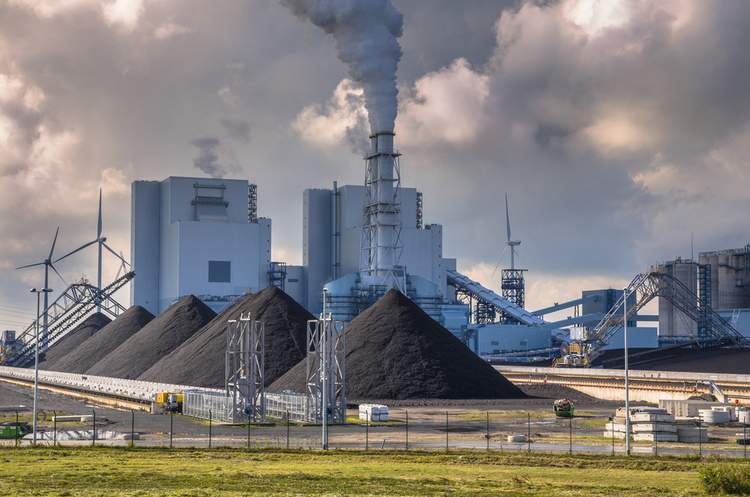
What is the problem?
The coal industry began to decline in Ukraine in the 1990s. Instead of making money from the mines, the state had to spend money to support their unprofitable work.
"The coal industry in Ukraine has been deeply subsidized because we have to essentially support it to continue using coal for thermal power plants," says Anastasiia Bushovska, an expert on urban energy policy.

Anastasiia Bushovska is an expert on urban energy policy. Photo from the Ecoaction website
With the start of the war in Ukraine's east in 2014 and a full-scale invasion, the industry's problems only worsened, as some mines were occupied and some of them flooded. Now, the Russians have destroyed approximately 80% of coal generation. It will take years and significant funding to restore the coal industry. In addition, not everything can be restored, such as flooded coal mines.
At the same time, there is no need to restore the way it was before. A centralized Soviet-style energy system that requires the preservation of unprofitable mines is inefficient and harmful. Coal mining and burning harms the environment and the health of Ukrainians. Dependence on a centralized energy system calls into question energy security in the conditions of a war with an aggressor country.
It is also impractical to restore this industry because Ukraine is a candidate for joining the European Union, which defines decarbonization by 2050 as its goal. That is, Ukraine needs to reduce emissions of greenhouse gases into the atmosphere and not increase them again. The further Ukraine delays the resolution of the issue of decarbonization, the more challenges it will face, for example, due to the Carbon Border Adjustment Mechanism (SBAM), which the EU will introduce from January 1, 2026.
Therefore, the movement of Ukraine toward closing mines is inevitable, and it is worth reducing the coal industry's role in Ukraine's energy sector. However, the question remains of what to do with the towns where the mines were and the people who worked for them.
What is the solution?
Coal is mined in Ukraine's Donetsk, Luhansk, Lviv, and Volyn regions. Cities that do this are usually entirely dependent on coal mining and cannot exist without it. Simply closing their mines means stopping the life of the city and its inhabitants.
However, the city won't disappear if its economy is first reconfigured so that the mine is not the only place of employment and source of income. Such a process is part of the fair transition, which involves a series of economic, social, and environmental measures that will overcome the challenges caused by the operation and closure of mines and other coal industry enterprises.
Many cities built around mines or coal-fired power plants have a monoeconomic model. So that the city does not disappear when this coal industry enterprise closes, it must be gradually replaced by other industries or developed in other sectors such as education, tourism, or agriculture," explains Bushovska.
How does it work?
To implement a fair transition, one must first fully understand its components. A fair transition is possible only if a new economic model of the city is developed, which involves diversifying the economy. The city should not depend on one industry. Therefore, it is necessary to create favorable conditions for the opening of small and medium-sized businesses and adapt education and local governance.
In the case of such changes, new jobs must be created for miners and other industry workers. Such a transformation can be called just only if the new working conditions correspond to the previous salary and qualification level. Retraining or other employment support programs can be helpful in this process.
Currently, there are many examples of transformation in Europe, the US, China, and Australia from which Ukraine can draw ideas and experiences. International experience indicates that solar stations or wind turbines can be installed on the territory of former mines. At the same time, the production of elements for these stations or turbines can be localized in coal cities. However, for the territory to be suitable for further use, measures must be provided for the reclamation and restoration of contaminated territories. In this way, the negative impact on the environment will be reduced because the complex measures will contribute to the green development of the region and the country as a whole.
fair transition involves large-scale changes, so the main decisions will be made by the central government. At the same time, it is up to each individual community to implement specific decisions and define its own action plan. That is why it is crucial to take into account the local specifics and needs of each individual region. This is another component of the concept — an individual approach to each area.
"fair transition is a set of economic, environmental, and social policies. Only in the complex is it a fair transition," says the expert.

Illustrative photo. Photo: Shutterstock
The next step is the selection of territories that need to be transformed in the transition from coal generation. The criteria for choosing communities are quite simple:
- the coal industry far outweighs others and dominates the region;
- the majority of the population works or used to work in this field;
- the local economy is directly or indirectly dependent on the coal industry.
Such cities in Ukraine include those where mines, coal beneficiation enterprises, or thermal power plants operate. In this case, more than 30 communities across Ukraine's entire territory need a fair transition.
Having decided on the region, it is necessary to understand its features and potential for development. To collect information, you need to answer a series of questions, which can be divided into four blocks:
- Demographic data. Who are the people for whom a fair transition is being made? What is the age structure of the population? How many young people left the region, and how many remain?
- Infrastructure. What roads and interchanges pass through this location? How well-developed is the utility infrastructure? Which industrial facilities are still working and which are not?
- Business environment. What companies have started in this location in the last 20 years? What are their needs? What is needed for their development and growth of the number of employees at the enterprise?
- Geography. What type of agriculture is the region's land suitable for? Is there tourist potential? Is there a place to put solar panels or wind turbines?
It is also essential to understand that although several activists or even one person can promote such changes in their community, one activist will not be enough to implement everything planned. It is important to cooperate with activists, local opinion leaders, trade unions, representatives of science and business with local authorities to form a joint action plan.
At the same time, it is necessary to work with the community and involve as many opinions as possible in the transformation process to consider the opinions of local people who will be affected by any changes.
Ideally, the community should already have developed a culture of discussion and public associations that will help to hear the community's opinions. But this is not the case everywhere, so it is worth looking for alternative ways since it will not be possible to talk to absolutely every inhabitant of even a small town. It is possible to involve doctors, teachers, or salespeople in the local store in the discussions because they communicate with a wide sample of the population.
The largest possible number of population groups should be involved in the transformation planning process at the local level. It is necessary to involve both those who will be directly affected by this transformation—for example, miners and their families—and those who will be indirectly affected. It is important to ensure equal involvement of different groups.
During discussions in the community and with local authorities, you can look at the success stories of other countries. However, it is necessary to remember the uniqueness of each region so that you cannot blindly repeat someone else's decision. International experience should be a source of inspiration or a bank of ideas that will help solve the problems of the region.

Illustrative photo. Photo: Eastern Variant
When the activists, the community, and the local government work out a joint plan to transform their region, one more player should be involved — the central government. Without coordination and practical cooperation, the project cannot be implemented because the process will require large-scale changes for the region and the entire country's energy system, as well as significant finances. Therefore, at the state level, it is necessary to promote draft laws and find budgets for transformation.
The last step of a fair transition is the distribution of finances. Simply allocating money to build a solar panel factory or install wind turbines instead of closed mines is insufficient.
Funding will also be needed, in particular, to support the region's residents. For example, to stimulate local businesses or conduct courses or training for former coal industry workers because supporting them in finding a new job will be essential.
"These can be support programs for small and medium-sized enterprises, measures for retraining or the creation of cultural spaces where people could interact, learn from each other, and so on," says the expert on urban energy policy.
Instead of conclusions
Thus, a fair transition involves four main areas of change: energy, environment, economy, and social components.
Changes in energy mean transitioning from coal-dependent energy to renewable energy sources — such as solar panels or wind turbines. Localizing their production in cities where mines used to be is also possible. At the same time, it is also possible to switch to non-energy industries. The main thing is to abandon enterprises that harm the environment, which will also contribute to Ukraine's European integration. It will help diversify the economy and give impetus to the development of technological productions that are not related to each other, which will allow the city not to be dependent on one industry. Such changes will enable the development of small and medium-sized businesses.
At the same time, such a transformation is fair because it is people-oriented. The changes brought about by this process should improve the lives of residents of coal cities. The transformation involves maintaining and improving the region's social and cultural infrastructure.
The social component of such changes will also promote equality of treatment and opportunity. Locals will have support from the state and a chance to repurpose.






